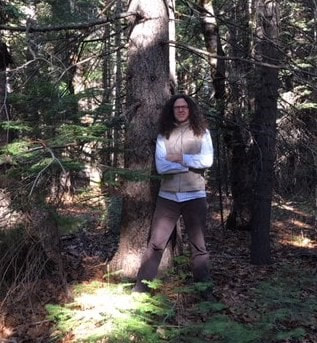Place-Based Writing

Will Lombardi has lived in Quincy since 1987. He worked in the woods fighting fire on the Plumas Hotshots, he worked on construction sites around the county, and now he teaches writing, literature, and humanities courses at Feather River College. The best days of Will’s life have been spent in the Feather River region with his partner Jenny Bennett, their son Hawk Lombardi, and the amazing friends he has met here along the way, in the woods and along the streams and rivers.
Will will host writing workshops at locations throughout the county during February, March, and April, based on regional interest. The workshops are designed to produce short profiles and/or reflections of life in the Feather River watershed. Participants will compose 300-500 word personal essays about a place, person, or event that epitomizes Plumas County to them. Subjects can range from the ordinary to the spectacular—raking leaves, taking a hike, life in the woods or on the farm, or a perfect snow day; big fish, first loves, and heartfelt losses. Those attending workshops can expect a lively, informative, supportive environment for getting their ideas on paper.
Will will host writing workshops at locations throughout the county during February, March, and April, based on regional interest. The workshops are designed to produce short profiles and/or reflections of life in the Feather River watershed. Participants will compose 300-500 word personal essays about a place, person, or event that epitomizes Plumas County to them. Subjects can range from the ordinary to the spectacular—raking leaves, taking a hike, life in the woods or on the farm, or a perfect snow day; big fish, first loves, and heartfelt losses. Those attending workshops can expect a lively, informative, supportive environment for getting their ideas on paper.
Workshop Overview
“Now + Here” is a record of place documenting our past and present.
Whether we write down our meaningful experiences or not, story-telling at heart concerns itself with remembering and preserving. Our stories make us visible and legible to one another. Stories protect our most cherished memories. Story-telling is a form of empowerment: to tell our stories ourselves is to have authority over our own narratives; in stories, we create ourselves and control who we might be. But story-telling makes us vulnerable too: it exposes our dreams and desires; in stories, we reveal what we need, what we hope for, and what we expect from each other.
Memory, empowerment, and vulnerability, then, are the conditions of a tale well told.
Place-based stories emphasize the ways in which our identities are formed by our surroundings. They explore our relationships to the culture and nature of our communities, and they define those webs or networks of interdependence that bind us to a given locale. Of course, where we live can either be limiting or liberating or both. In this regard, our place-based stories position us as witnesses to what life is really like, here and now. They allow us to create individually and collectively. If we want them to, our stories can be both agents of change in our communities and a stabilizing force.
Each personal reflection adds to the confluence of narratives contributing to the spirit and sense of a certain time and place in the world.
The People of Plumas Writing Project is a collaborative, grassroots effort that makes space for all interested community members to share their reflections on what it means to be in Plumas County and the Feather River Watershed. Now + Here is an opportunity to bear witness to, and tell our own truth about, where we dwell. Taken together, each narrative will intertwine in such a way that they tell our story, in its richness, diversity, and uniqueness.
Whether we write down our meaningful experiences or not, story-telling at heart concerns itself with remembering and preserving. Our stories make us visible and legible to one another. Stories protect our most cherished memories. Story-telling is a form of empowerment: to tell our stories ourselves is to have authority over our own narratives; in stories, we create ourselves and control who we might be. But story-telling makes us vulnerable too: it exposes our dreams and desires; in stories, we reveal what we need, what we hope for, and what we expect from each other.
Memory, empowerment, and vulnerability, then, are the conditions of a tale well told.
Place-based stories emphasize the ways in which our identities are formed by our surroundings. They explore our relationships to the culture and nature of our communities, and they define those webs or networks of interdependence that bind us to a given locale. Of course, where we live can either be limiting or liberating or both. In this regard, our place-based stories position us as witnesses to what life is really like, here and now. They allow us to create individually and collectively. If we want them to, our stories can be both agents of change in our communities and a stabilizing force.
Each personal reflection adds to the confluence of narratives contributing to the spirit and sense of a certain time and place in the world.
The People of Plumas Writing Project is a collaborative, grassroots effort that makes space for all interested community members to share their reflections on what it means to be in Plumas County and the Feather River Watershed. Now + Here is an opportunity to bear witness to, and tell our own truth about, where we dwell. Taken together, each narrative will intertwine in such a way that they tell our story, in its richness, diversity, and uniqueness.
Work Samples
Walking with Rattana on Mill Creek Trail
Rattana was an artist. She began to paint in 1994, when we moved to Myanmar, studying oil painting with an old Burmese gentleman named U Than Aung. When we moved to Quincy in 1999, Rattana took art classes at Feather River College and became close friends with one the art teachers, Dianne. They often went for long walks together and I especially remember one day when they went for a hike somewhere out in the forest. Rattana came home with a big smile and a bunch of fresh porcini mushrooms that became the main ingredient of a Cambodian stir-fry. She told me about meeting a Japanese man, Taro, and walking with him to one of his “secret” mushroom places.
During late August of 2009, our friends Jim and Lynne invited us out for a hike on Mill Creek Trail. Rattana was in a great mood that day, a Saturday following a hard week of work at the pre-school she had at our home. She was also pleased to be walking on the Mill Creek trail, which she often hiked on with Dianne. With a gleam in her eyes she recalled the day that Taro had taken her and Dianne to hunt mushrooms....
Rattana was an artist. She began to paint in 1994, when we moved to Myanmar, studying oil painting with an old Burmese gentleman named U Than Aung. When we moved to Quincy in 1999, Rattana took art classes at Feather River College and became close friends with one the art teachers, Dianne. They often went for long walks together and I especially remember one day when they went for a hike somewhere out in the forest. Rattana came home with a big smile and a bunch of fresh porcini mushrooms that became the main ingredient of a Cambodian stir-fry. She told me about meeting a Japanese man, Taro, and walking with him to one of his “secret” mushroom places.
During late August of 2009, our friends Jim and Lynne invited us out for a hike on Mill Creek Trail. Rattana was in a great mood that day, a Saturday following a hard week of work at the pre-school she had at our home. She was also pleased to be walking on the Mill Creek trail, which she often hiked on with Dianne. With a gleam in her eyes she recalled the day that Taro had taken her and Dianne to hunt mushrooms....
|
Driving to Wayne: My Plumas County story
I’ve been back & forth for almost 3 years now from the Haight surrounded by millions to Quincy, far away. … Downhill to Oak Street on past NOPA lower Haight Hayes Valley the ramp to the 80 stop and go to the Bridge wedged in. |
Yerba Buena tunnel opens into light
water sky white pillars Oakland cranes then the Berkeley slowdown. I stay left to Richmond, San Pablo, Pinole, Hercules Chevron’s hillside tanks Rodeo and Crockett and the old C&H factory over the blue Carquinez Strait Vallejo. Then up, over and down to Fairfield with its slowdown which I never understand. and eventually there is Vacaville. |
Fifty years ago
our station wagon stopped here on trips south from Oregon. The Nut Tree was something. Actual nut trees the shade they gave the toy train sweet nut bread a respite from the freeway. This was California. Now it’s a fading outlet mall every fast food joint all the retail hangers on how long will they hang on? The nut trees are gone.... |
Nicholas Cage’s 1998 City of Angels movie has a scene: when a human dies, the Angel retrieving that soul asks, “What was your favorite part?” If I were asked, my reply would be: “Wow, those were some amazing days, maybe even some of the very best days of our lives.”
It was our first summer in Chester. We were Bay Area transplants, coming to manage a B & B Inn. We were provided a one hundred-year-old barn residence next door to the Inn, and we spent the previous fall and winter renovating it to make it family-living worthy. We were a young couple, both in our twenties, with three children, ages seven, three, and two.
After our first winter, exhausted by the changes from the past year and by our small children, we decided to go on an adventure whose sole purpose was enjoying a day exploring and playing. We had not had a day off for about 10 months.
We stuffed our family of five, as well as our Rhodesian Ridgeback, into our newly purchased for $250, 1967, rusty, sun-bleached baby blue and white VW bus, a total jalopy: springs poking out of seats, no air-conditioner or heater, small rusted holes through the floor just big enough to watch asphalt whiz by, car seats bolted to the floors; and we headed off to a beach in an undetermined location at Butt lake, about 15 miles from our barn dwelling.
It was our first summer in Chester. We were Bay Area transplants, coming to manage a B & B Inn. We were provided a one hundred-year-old barn residence next door to the Inn, and we spent the previous fall and winter renovating it to make it family-living worthy. We were a young couple, both in our twenties, with three children, ages seven, three, and two.
After our first winter, exhausted by the changes from the past year and by our small children, we decided to go on an adventure whose sole purpose was enjoying a day exploring and playing. We had not had a day off for about 10 months.
We stuffed our family of five, as well as our Rhodesian Ridgeback, into our newly purchased for $250, 1967, rusty, sun-bleached baby blue and white VW bus, a total jalopy: springs poking out of seats, no air-conditioner or heater, small rusted holes through the floor just big enough to watch asphalt whiz by, car seats bolted to the floors; and we headed off to a beach in an undetermined location at Butt lake, about 15 miles from our barn dwelling.
Whatever you decide to write about, there is space for your story here!





